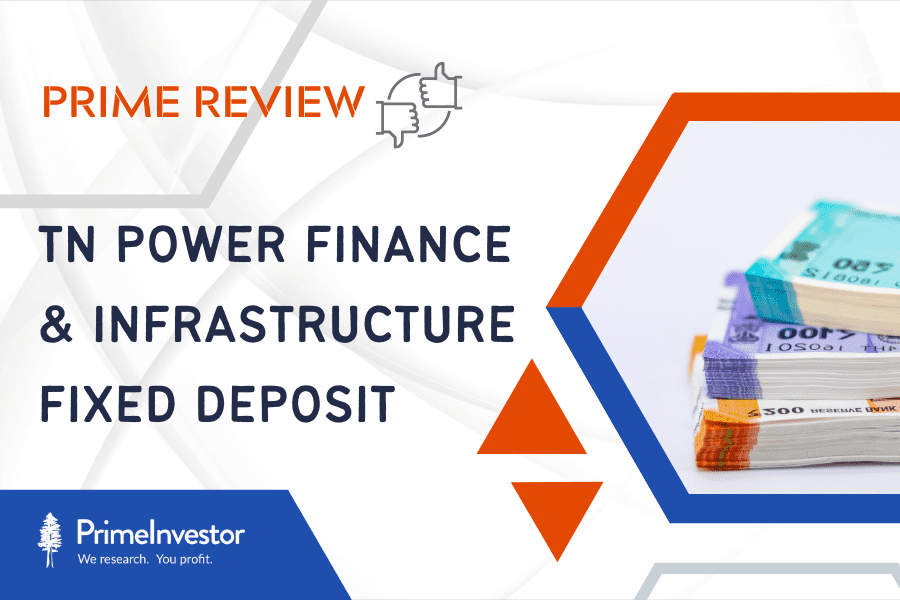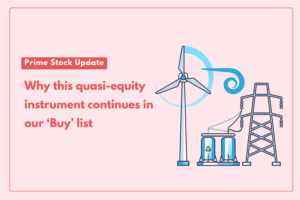When interest rates on bank deposits hit rock-bottom in the last few years, the fixed deposit (FD) programme from Tamil Nadu Power Finance and Infrastructure Corporation (TNPFIC) turned quite a hit. This NBFC owned by the Tamil Nadu Government offers high interest rates of 7-8% on FDs and has a friendly online interface, making it very popular with fixed income seekers and seniors. We have received a number of queries from many of you, about this TN Power Finance and Infrastructure fixed deposit.
As we said in our article on choosing deposit schemes, when you get high interest rates from any FD scheme, it pays to understand where the high returns are coming from. The high interest rates offered by TNPFIC’s FD programme reflect the risks inherent in its lending business. Here’s a review.

What it offers
TNPFIC is an unlisted, RBI-registered deposit-taking NBFC which is wholly owned by the Government of Tamil Nadu, incorporated in 1991. It is designated as a Public Financial Institution and is managed by a Chairman and MD, with a Board manned by senior IAS officers and professional independent directors. You’ll find more details on the company here.
TNPFIC runs an FD programme with both regular and cumulative options. The basic details on the FD are as follows:
- The minimum deposit is Rs 50,000.
- FDs are available for tenors ranging from 12 months to 60 months
- The regular income option pays interest on a quarterly basis.
- Premature withdrawals before maturity date are allowed only after a minimum of 3 months. For deposits closed within 6 months no interest is paid. For deposits closed within a year, depositors need to forego 3 percentage points of interest and for deposits closed after completion of a year the penalty is 2 percentage points. These penalties are much stiffer than those of 0.5-1% usually imposed by deposit-taking entities. It would therefore be unattractive for investors to consider premature withdrawals from this FD.
FDs can be opened in online mode as well as through physical application. Forms are available for download here. Current interest rates are as below.
Effective yields for the cumulative option work out to 7.1% to 8.24%. Seniors get 0.5% extra across tenures.
The business
As NBFCs go, TNPFIC’s business is quite simple. It raises funds by way of bonds and fixed deposits from the public and TN government institutions on its balance sheet, and on-lends this money as loans to the TN government’s power distribution and generation company – TANGEDCO. Though TNPFIC is officially classified as a hire purchase finance company, it has been engaged in providing loans only to TANGEDO in recent years.
TANGEDCO has been in need of regular financing support from TNPFIC because as a State power utility, the revenues it earns from generating and supplying power to the State’s users routinely fall short of the costs it incurs in generating and distributing power. This situation is not unique to TN. It is in fact the case with most State power utilities owing to free power supplied to beneficiaries such as farmers and the need to keep household power tariffs affordable.
TANGEDCO’s latest financials for FY21 show total expenses at Rs 76,795 crore exceeding revenues of Rs 63,388 crore, resulting in a net loss of Rs 13,407 crore. This situation is likely to have improved a little with power demand surging after Covid and recent tariff revisions announced by the TN government, but the losses are unlikely to be bridged.
As of March 2021, TANGEDCO had negative net worth and long term and short-term borrowings totalling to Rs 1.44 lakh crore on its balance sheet. Being critical to the TN state’s power supply, TANGEDCO receives support from the State government to tide over its funds crunch. TNPFIC accounts for 27% of TANGEDCO’s borrowings, and the latter also raises funds from other sources.
Unlike TANGEDCO though, TNPFIC has been a profitable company. Its revenues, earned mainly by way of interest from TANGEDCO loans and investments, have been rising at a double-digit pace owing to TANGEDCO’s rising needs for funding. TNPFIC earns a positive spread between the interest rate at which it raises FDs and the rate at which lends to TANGEDCO. TNPFIC doesn’t have much flexibility to charge TANGEDCO a high interest on its loans, but with the cost of deposits being low in the last couple of years, it has seen better profitability. But its profit margins are still thin at 1.4-1.7%.
When an NBFC keeps expanding its loan book, RBI’s prudential norms require it to bring in equity capital to adhere to minimum capital adequacy ratios. As per the concessional norms applicable to it, TNPFIC was required to maintain a CRAR of 12%, 13% and 15% by March 2020, 2021 and 2022. TNPFIC has managed to just about meet these norms with capital infusions from the TN government. It reported a CRAR of 12.1% and 13.2% as of March 2020 and March 2021.
As a public financial institution though, TNPFIC has sought exemption from RBI on credit concentration norms. As a lender to a State government entity, it does not provision for the possibility of defaults from its main borrower. It is however required to maintain sufficient cash in liquid assets to meet its outflows, including the repayment and servicing of deposits.
Risks
The above business details of TNPFIC underline the following risks to investing in its FD.
#1 Borrower concentration
Usually, the health of an NBFC or bank’s loan book is assessed by the diversity of its loan book. The larger number of sectors it lends to, the lower the risks of the institution being taken down by a single borrower. With TNPFIC, there’s only a single borrower TANGEDCO from a sector (State discom) that is highly leveraged. TNPFIC’s ability to service its deposits therefore rely a lot on TANGEDCO keeping up its loan repayments and interest payments - as it has done so far.
#2 Government backing, but not guarantee
While bonds issued by TNPFIC are backed by an explicit unconditional and irrevocable guarantee from the TN government, its FD programme is not backed by an explicit guarantee. However, as the Corporation is wholly owned by the TN government, financial backing from the TN government is taken as implicit.
In the past, whenever TNPFIC has fallen short of capital adequacy requirements specified by RBI, the TN government has stepped in to shore up the equity base of the NBFC. But there has been no occasion to test if the TN government will offer financial or liquidity support for servicing the FDs, because TNPFIC has never defaulted on either the interest or principal payments on its FDs.
# 3 Concentrated funding
NBFCs run a leveraged business. Should their own funding sources or liquidity from markets dry up, they can find it tough to service their public deposits. Therefore, good deposit-taking NBFCs such as a HDFC or Sundaram Finance usually limit deposits to a fraction of their fund base, while raising money from bond markets, overseas borrowings and banks.
TNPFIC, however, relies on fixed deposits for 100% of its funding. Though it had bond market borrowings earlier, it has redeemed these bonds early in 2022. Should deposits dry up as a source of funds, TNPFIC could face a liquidity crunch to service its older deposits. However, public depositors can take some comfort from the fact that nearly 80% of its FDs are raised from TN government institutions such as educational institutions, municipalities and infrastructure development institutions. Only 21% of the FDs are from the public.
#4 Regulatory risks
The key risk to TNPFIC’s finances arises from TANGEDCO defaulting or delaying on its interest or loan repayments to it. Given the state of TANGEDCO’s finances, this risk can materialise if Central government power generators or distributors apply pressure on State discoms to immediately repay their debt.
High losses and mounting leverage have been a long-standing problem. But after trying out various methods to clean up discom dues such as UDAY scheme (which didn’t prove successful), the current ruling regime has been upping the ante on rising discom debt lately. Very recently, State discoms were barred from tapping into the spot market for power if they failed to clear their pending dues (Read about it here).
Should the Central government decide to initiate hard steps to force State discoms to pay up their dues, this could put a lot of financial and liquidity pressure on TANGEDCO, which is among the State utilities with the largest dues. This in turn could impact its servicing of loans that are repayable to TNPFIC.
However, given that any delay or default on public deposits by TNPFIC would mean significant reputational damage to the State government, it is unlikely that the State government would allow things to come to such a pass.
The above factors are all the reasons why ICRA, the primary rating agency for TNPFIC’s bonds and FD programme, rates it at BBB minus, the last rung of the investment grade, despite it being a State government entity (The rating changed from MA minus to BBB minus when ICRA migrated TNPFIC from a medium term to long term rating scale due to regulatory changes. Details are here). You can read ICRA’s rating rationale here.
Returns vs risk
The key call that retail FD investors have to take, therefore, is whether the slightly higher interest rates on the TNPFIC FD compensate for these risks and the relatively low credit rating of this institution. The following table gives you an idea of the current yields at which the Central government and companies with high credit ratings borrow money from bond markets. Clearly, even AA-rated entities offer higher yields than TNPFIC at 8.5-10%.
Based on the above comparison, we feel that the current yields on the TNPFIC FD do not entirely compensate for the risks inherent in the business.
- For investors or seniors looking for growth of capital over periods such as 3-5 years, corporate bond funds or SDL funds with target maturity may be good options that combine attractive yields with higher portfolio quality. Refer to Prime Funds for corporate bond fund recommendations. Apart from a more diversified portfolio, these funds will allow you to treat your accumulated interest as long-term capital gains after 3 years, leading to lower tax incidence than with an FD.
- Seniors looking for regular income should first exhaust safe options such as Senior Citizens Savings Scheme (7.4% interest with easier premature withdrawal) and the deposits in our recommended list Prime Deposits before venturing to TNPFIC. Our readymade portfolios for retirees can be found here.
If you’d however still like to invest in the TNPFIC deposits for the convenience and TN government backing, you should cap the risk you’re taking to your capital in three ways:
- Choose the non-cumulative option so that you get regular cash flows
- Stick to 1 or 2-year FDs
- Make sure your overall allocation to this FD is no more than 5% of your debt allocation









1 thought on “Prime Review: TN Power Finance and Infrastructure Fixed Deposit”
Thank you for covering the NBFC in detail. There is a lot of influencing being done to the retirees to invest in this NBFC for the higher ROI.
In public interest, this article should be free to access and be available for all search engines to index and show.
Right information leads to right investments
Comments are closed.